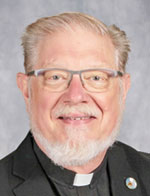That All May Be One / Fr. Rick Ginther
Our Creator loves those who live with gentleness, solidarity and compassion
 As I write this, the conclave to elect a new pope has commenced.
As I write this, the conclave to elect a new pope has commenced.
This is the eighth conclave of my lifetime; the first was 1958. In succession, they included: the deaths of Popes Pius XII, John XXIII, Paul VI, John Paul I, John Paul II, and the resignation of Pope Benedict XVI. And now, Pope Francis’ death.
In this Jubilee Year of Hope, we pilgrims journey toward our destination of eternal life. That journey is to be an example to the world—especially to people of faith, whatever that faith may be.
During a memorial Mass for Pope Francis in St. Peter’s Basilica on April 29, Cardinal Mauro Gambetti, the archpriest of St. Peter’s Basilica, preached on Mt 25:31-36 in which Christ described the final judgment when the Son of Man will separate the sheep from the goats.
Following is a lengthy excerpt:
Th[is] Gospel passage is well known. A grand scene with a universalistic character: All peoples, living together in the one field that is the world, are gathered before the Son of Man, seated on the throne of his glory to judge,” Cardinal Gambetti said.
The message is clear: In the lives of all, believers and nonbelievers alike, there is a moment of discrimination; at a certain point some begin to share in the same joy of God, others begin to suffer the tremendous suffering of true loneliness, because, ousted from the kingdom, they remain desperately alone in their souls.
The Italian translation [CEI] speaks of sheep and goats to distinguish the two groups. The Greek, however, alongside the feminine próbata—flock, sheep—uses èrífia, which indicates primarily goats, the males of the species.
Sheep, who do not rebel, are faithful, meek, take care of the lambs and the weakest of the flock, enter the realm prepared for them since the creation of the world; goats, who want independence, defy the shepherd and other animals with their horns, jump over the other goats as a sign of dominance, think of themselves and not the rest of the flock in the face of danger, are destined for eternal fire.
It is natural to ask: On a personal and institutional level, which of the two styles do we embody?
Clearly, then, whether or not we belong to the kingdom of God does not depend on explicit knowledge of Christ: Lord, when did we see you hungry … thirsty … a stranger … naked … sick or in prison?
In the Greek text, the verb ‘to see’ is expressed by Matthew as òráo, which means to see deeply, to perceive, to understand. Paraphrasing: Lord, when did we “understand,” “detect,” “distinguish” you?
Jesus’ answer suggests that it is not the profession of faith, theological knowledge or sacramental practice that guarantees participation in God’s joy, but qualitative and quantitative involvement in the human story of the least of our brothers and sisters.
And the price of the human is the kingship of Jesus of Nazareth, who in his earthly life shared in all the weakness of our nature, even to the point of being rejected, persecuted, and crucified.
Ultimately, the parable of the Last Judgment manifests the secret on which the world stands: The Word became flesh, that is, “God wanted to make himself in solidarity with humanity to such an extent that whoever touches man touches God, whoever honors man honors God, whoever despises man despises God” [quote by Elias Citterio].
Indeed, the parable reveals the supreme dignity of human acts, defined in relation to compassion, solidarity, tenderness, and closeness in humanity.
What a challenge for us who believe in the salvific action of Christ! We have been so named by him to manifest this love, compassion, tenderness and closeness!
Such witness can evangelize the world!
(Father Rick Ginther is director of the archdiocesan Office of Ecumenism and Interreligious Affairs. He is also the pastor of Our Lady of Lourdes Parish in Indianapolis.) †
 As I write this, the conclave to elect a new pope has commenced.
As I write this, the conclave to elect a new pope has commenced.